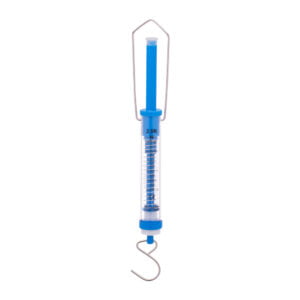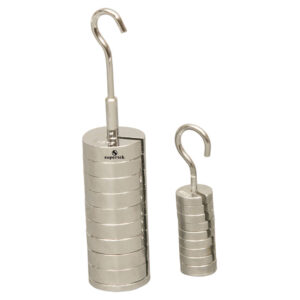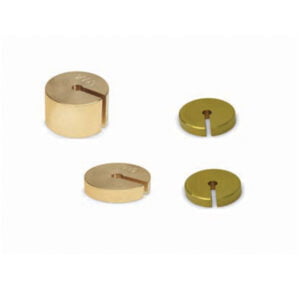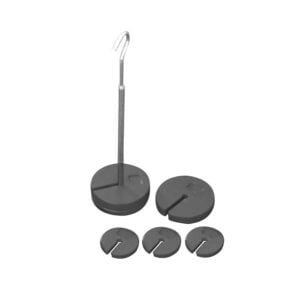-
Mechanics
Weight Set On Tray
Set of Mild steel and brass weights providing weighing range from 10 gm to 1990 gm. Contains six brass weights of two each of 100 gm, one each of 50 gm, one each of 20 gm and two each of 10 gm, three steel weights of one each of 1 kg, one each of 500 gm and one each of 200 gm. Housed in a molded tray.
PH10139 -
Mechanics
Hook Weight Set Economy
Black Painted weights have a non-movable hook on the top. Bottoms of the weights are recessed and contain a weight below bar allowing weights to be hung from each other. Weight set includes one each of 10 gm, 50 gm, 100 gm, 500 gm and 1Kg. Two each of 20 gm & 200 gm. In plastic molded box.
PH10185 -
Mechanics
Hook Weight Set
Set consists of seven polished brass weights and two black enameled weights with flat countersunk bottoms. Each weight is accurately adjusted and the value clearly indicated. Individual masses are as follows: 1 x 10 gm, 2 x 20 gm, 1 x 50 gm, 1 x 100 gm, 2 x 200 gm, 1 x 500 gm, 1 x 1000 gm.
PH10190 -
Mechanics
Force Table Introductory
Wooden Table of 40 cm diameter having angular resolution to the nearest 0.5 Degree, supported on three adjustable legs. Each line is passed through a quarter bend of glass tubing, Equipped with four glass quarter bends, four weight hangers, 20 washers, one string set and instruction manual.
PH10215 -
Mechanics
Force Table
For verifying laws of composition and resolution of forces, comprising a machined aluminium table 40 cm dia., scale graduated 360°, on heavy vertical support rod and tripod base. Complete with one ring, 4 sliding clamp pulleys. Supplied with four cords with rings at one end, without masses.
PH10220 -
-
Mechanics
Parallelogram of Force Apparatus
This product is similar to the wall type but is intended for use in laboratories where wall space is limited. Thick plywood pieces of thickness 12 mm having dimension 45 × 30 cm on a substantial wooden stand supplied with 2 sets of z-pulleys, 3 sets of slotted weights (50 gms x 5), 5 sets of drawing sheets, one packet of drawing pin, two mirror strips and cords.
PH10227S -
Mechanics
Roman Arch
Demonstrates the typical concept behind the architecture of Roman arch structures, which are famous for their strength in compressive loading. Comprise of a pre-assembled 3-part buttress and a set of 23 wooden blocks. A fully assembled arch can easily support the weight of a child.
PH10229


















